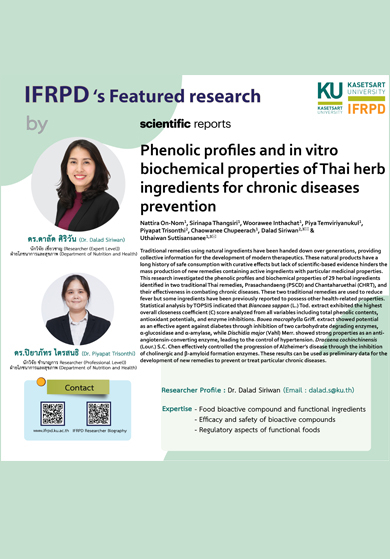| ผลงานวิจัย | ดร.ดาลัด ศิริวัน และคณะ |
| Keywords | Phenolic profiles; biochemical properties; Covid-19; Prasachandaeng (PSCD); Chantaharuethai (CHRT) |
| Telephone | 0 2942 8629 (1906) |
| dalad.s@ku.th | |
| URL | https://doi.org/10.1038/s41598-023-49074-5 |

Phenolic profiles and in vitro biochemical properties of Thai herb ingredients for chronic diseases prevention

| ผลงานวิจัย | ดร.ดาลัด ศิริวัน และคณะ |
| Keywords | Phenolic profiles; biochemical properties; Covid-19; Prasachandaeng (PSCD); Chantaharuethai (CHRT) |
| Telephone | 0 2942 8629 (1906) |
| dalad.s@ku.th | |
| URL | https://doi.org/10.1038/s41598-023-49074-5 |
จุดเด่นผลงาน
บทสรุป : เป็นการศึกษาปริมาณสารสำคัญและฤทธิ์ทางชีวภาพ ซึ่งเกี่ยวข้องกับคุณสมบัติการเป็น functional ingredients ของส่วนผสมสมุนไพร 29 ชนิด ที่เป็นองค์ประกอบของตำรับยา2 ชนิด คือ ยาประสะจันทน์แดง (PSCD) และ จันทหฤทัย (CHRT) ยาแผนโบราณทั้งสองชนิดนี้ใช้เพื่อลดไข้ ซึ่งในการศึกษาพบว่า สมุนไพรที่เป็นองค์ประกอบในตำรับยานี้ มีศักยภาพในการต้านอนุมูลอิสระและการยับยั้งเอนไซม์ที่ก่อให้เกิดโรค NCDs หลาย ๆ ชนิดในระดับหลอดทดลอง เช่น เบาหวาน ความดันโลหิตสูงและอัลไซเมอร์ ทั้งนี้ได้มีการนำสถิติ PCA และ (TOPSIS) มาใช้ดูความสัมพันธ์ระหว่างฤทธิ์ทางชีวภาพและปริมาณสารสำคัญในสมุนไพรแต่ละชนิด
Abstract : Traditional remedies using natural ingredients have been handed down over generations, providing collective information for the development of modern therapeutics. These natural products have a long history of safe consumption with curative effects but lack of scientific-based evidence hinders the mass production of new remedies containing active ingredients with particular medicinal properties. This research investigated the phenolic profiles and biochemical properties of 29 herbal ingredients identified in two traditional Thai remedies, Prasachandaeng (PSCD) and Chantaharuethai (CHRT), and their effectiveness in combating chronic diseases. These two traditional remedies are used to reduce fever but some ingredients have been previously reported to possess other health-related properties. Statistical analysis by TOPSIS indicated that Biancaea sappan (L.) Tod. extract exhibited the highest overall closeness coefficient (C) score analyzed from all variables including total phenolic contents, antioxidant potentials, and enzyme inhibitions. Bouea macrophylla Griff. extract showed potential as an effective agent against diabetes through inhibition of two carbohydrate degrading enzymes, α-glucosidase and α-amylase, while Dischidia major (Vahl) Merr. showed strong properties as an anti-angiotensin-converting enzyme, leading to the control of hypertension. Dracaena cochinchinensis (Lour.) S.C. Chen effectively controlled the progression of Alzheimer’s disease through the inhibition of cholinergic and β-amyloid formation enzymes. These results can be used as preliminary data for the development of new remedies to prevent or treat particular chronic diseases.
Scientific Reports volume 13, Article number: 21690 (2023)